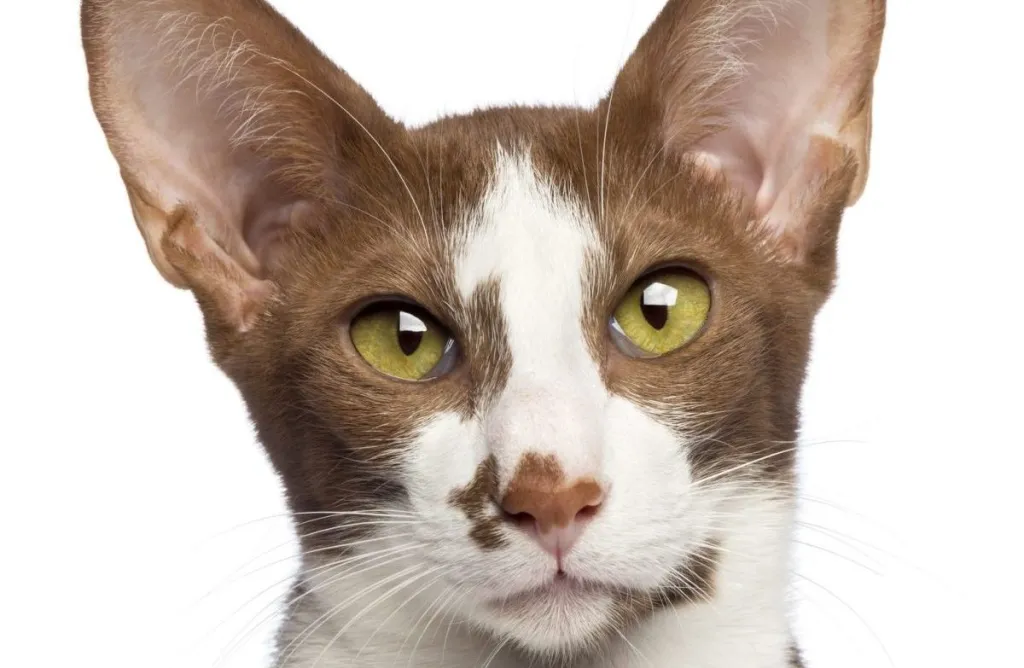The Oriental Shorthair cat breed is known for their sleek and elegant appearance. Sharing similar ancestry, they closely resemble the Siamese cat. With a long, slender body, large ears, and almond-shaped eyes, Oriental cats exude a sense of grace and sophistication. They come in a variety of colors and patterns, including solid, tabby, and bicolor. These feline companions are sociable and intelligent, forming strong bonds with their human families. They are also vocal and enjoy communicating with their owners. Their playful and active nature makes them well-suited for interactive games and activities, and they often appreciate being the center of attention.
Oriental Shorthair cats share many characteristics with the Siamese breed, including a short, fine coat that lies close to their body. Their coat requires minimal grooming, making them relatively low-maintenance in terms of grooming needs. The Oriental cat is a perfect choice for individuals or families seeking a loving and interactive companion with an unmistakable sense of style.
When considering an Oriental Shorthair kitten, it’s advisable to prioritize adopting from rescue organizations or shelters to provide a loving home to a cat in need. However, if you decide to purchase, it’s crucial to choose a reputable breeder. Conduct thorough research to ensure that the breeder follows ethical practices and prioritizes the well-being of their cats. Reputable Oriental Shorthair kitten breeders prioritize the health and temperament of their cats, conduct necessary health screenings, and provide a nurturing environment for the kitties. This active approach ensures that you bring home a healthy and happy kitty while discouraging unethical breeding practices.
Quick Facts
- Origin: United Kingdom, developed in the 1950s by crossing Siamese with other shorthaired breeds to create a new, elegant type.
- Size: Medium (7-12 pounds)
- Breed Group: Oriental Shorthair (recognized by major associations)
- Lifespan: 15-20 years, known for their longevity.
- Coat: Short, sleek, and glossy, comes in a vast array of colors and patterns including solid, tabby, bi-color, tortoiseshell, and pointed (with blue eyes).
- Temperament: Intelligent, playful, loyal, affectionate, social, talkative, enjoys human interaction and playtime, often described as “dog-like” in their personality.
- Exercise Needs: Moderate – needs daily playtime and mental stimulation but can adapt to quieter lifestyles.
- Training: Highly trainable due to their intelligence and desire to please, can learn tricks and even leash training.
- Grooming: Minimal, weekly brushing to maintain their sleek coat.
- Health: Generally healthy, but some potential for genetic health conditions like hypertrophic cardiomyopathy (HCM) and progressive retinal atrophy (PRA).
- There are over 300 coat patterns for the Oriental Shorthair.
- Hobbikats on Instagram are some of the most well-known Oriental Shorthair cats.
- Sometimes their coats change color with the sun, becoming rusty and mottled.
Oriental Pictures
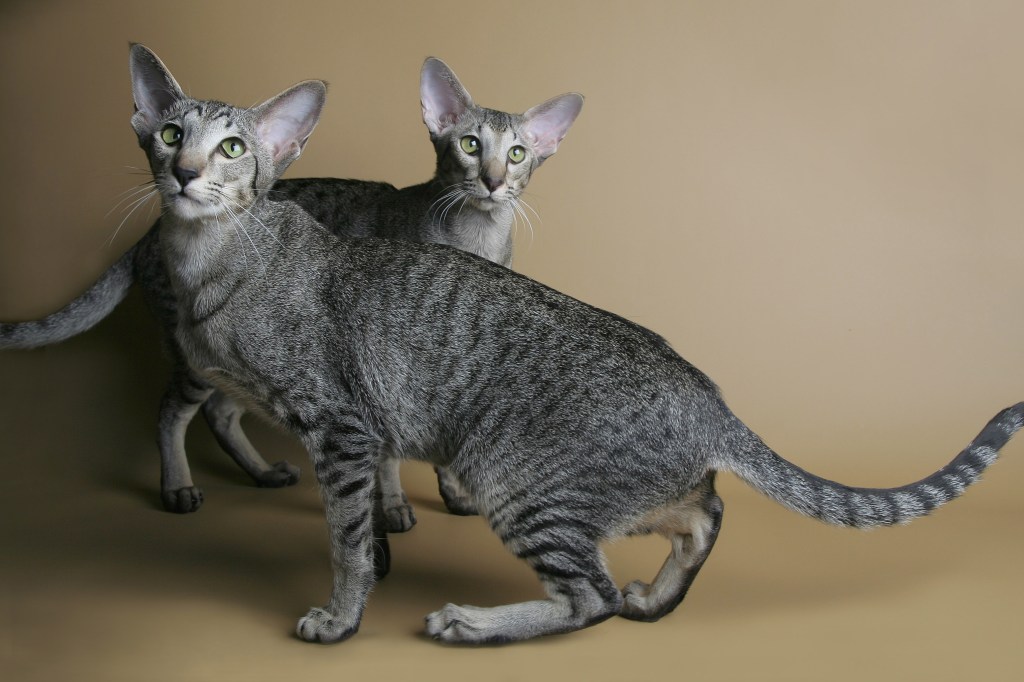
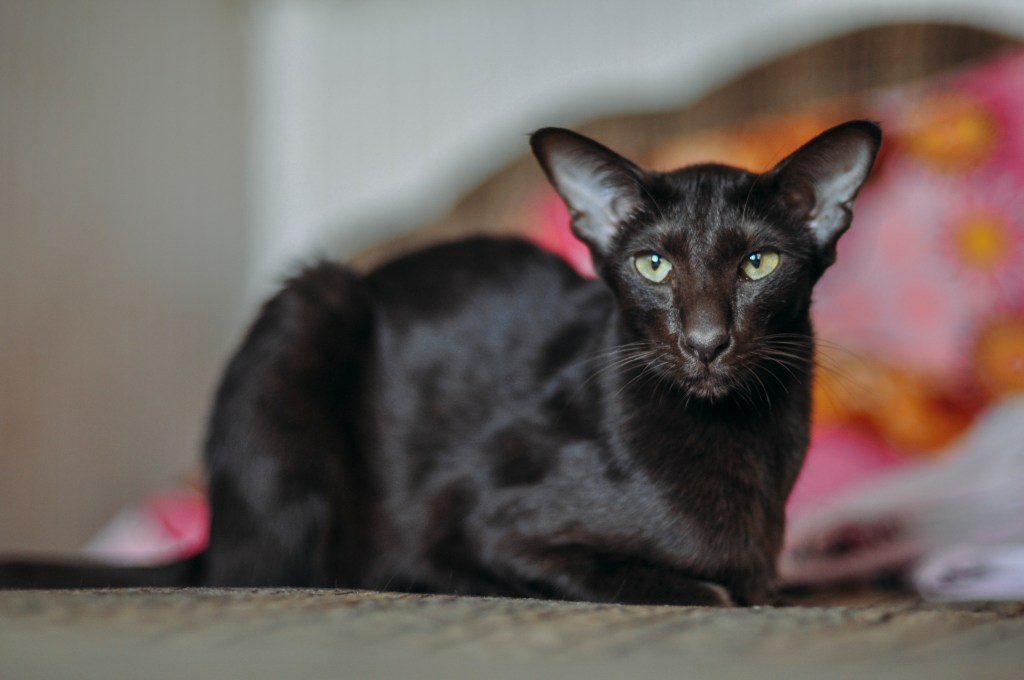
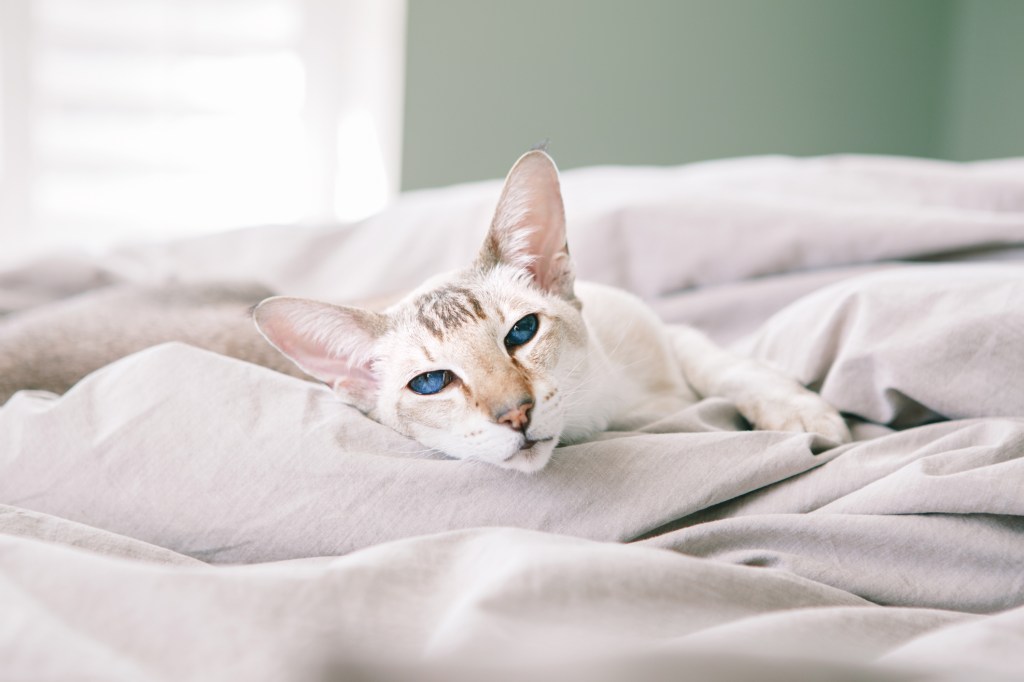
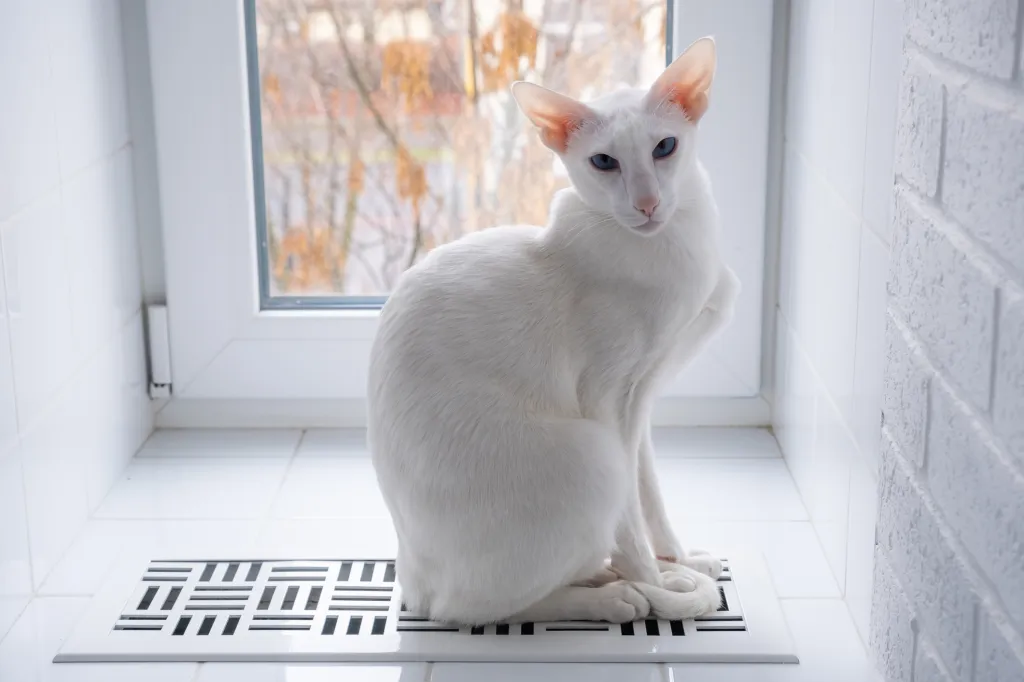
-
Tendency to Vocalize
Some breeds sound off more often than others with meows, yowls, and chattering. When choosing a breed, think about how the cat vocalizes and how often. If constant “conversation” drives you crazy, consider a kitty less likely to chat.
Oriental Shorthair History
The Oriental is best described as a color remake of the original “black and white” Siamese. The breed was developed using Siamese as the foundation breed and then crossing them with other breeds. The original intent was to broaden the Siamese gene pool in Britain because so many breeding programs had been devastated during World War II.
Crosses with Russian Blues, British Shorthairs, Abyssinians and domestic shorthairs produced kittens without the pointed Siamese pattern, which were then bred back to Siamese. In just a few generations, breeders produced cats that looked exactly like Siamese, except for the variety of colors and patterns they displayed, as well as cats with the traditional pointed pattern.
Cats with Siamese points were used in Siamese breeding programs, but the non-pointed cats became the basis for a new breed: the Oriental. When the cats began to be imported into the United States in the 1970s, crosses with American Shorthairs produced yet more colors and patterns. A longhaired variety was also developed. Today Orientals come in more than 300 colors and patterns, including pointed varieties. Pointed Orientals are not accepted by all cat associations, and some require them to be shown as Siamese.
Oriental Shorthair Size
Orientals are medium-size cats that typically weigh 5 to 10 pounds.
Oriental Shorthair Personality
The Siamese and the Oriental might differ in color, but beneath the skin they are identical. The Oriental is talkative and opinionated. He will tell you exactly what he thinks, in a loud, raspy voice, and he expects you to pay attention and act on his advice. Orientals are extremely fond of their people. They like to be “helpful” and will follow you around and supervise your every move. When you are sitting down, an Oriental will be in your lap, and at night he will be in bed with you, probably under the covers with his head on the pillow. Do not get an Oriental if living with a chatty busybody would drive you insane.
On the other hand, if you enjoy having someone to talk to throughout the day, an Oriental can be your best friend. Just be sure you have time to spend with this demanding and social cat. Orientals do not like being left alone for long periods, and if you work during the day it can be smart to get two of them so they can keep each other company.
The Oriental is highly intelligent, agile and athletic, and loves to play. Keep his busy brain active with puzzle toys and his body exercised with teaser toys that he can chase and a big cat tree he can climb. He is fully capable of opening doors and drawers or rifling through your purse in search of something interesting or shiny to play with. Never leave him without any form of entertainment, or you will likely come home to find that he has reprogrammed your DVR to record only nature shows or at the very least decided that your toilet paper rolls and tissue boxes look better empty.
Choose an Oriental if you look forward to spending time with and interacting with your cat. This is a loyal and loving feline who will pout and pine if given little or no attention. In the right home, however, he thrives for years.
Oriental Shorthair Health
Both pedigreed cats and mixed-breed cats have varying incidences of health problems that may be genetic in nature. The same problems that may affect the Siamese can also affect the Oriental, including the following:
- Amyloidosis: This is a disease that occurs when a type of protein called amyloid is deposited in body organs, primarily the liver in Siamese.
- Asthma: Asthma in cats, also known as feline bronchial disease or feline asthma, is a respiratory condition characterized by inflammation and constriction of the airways. It is a common condition in cats and can affect felines of any age or breed
- Congenital Heart Defects: Congenital heart defects in cats refer to abnormalities in the structure or function of the heart that are present at birth. These defects can vary in severity and may affect different parts of the heart. While some congenital heart defects may not cause significant health problems, others can lead to serious complications.
- Crossed Eyes: Crossed eyes in cats, also known as strabismus, is a condition where a cat’s eyes are misaligned and do not focus on the same point simultaneously. This can be a result of various factors and may affect one or both eyes.
- Megaesophagus: Megaesophagus in cats is a condition characterized by the abnormal enlargement of the esophagus, the muscular tube that transports food from the mouth to the stomach. This enlargement results in a loss of normal esophageal function, leading to difficulties in swallowing and regurgitation.
- Hyperesthesia Syndrome: This is a neurological problem that can cause cats to excessively groom themselves, leading to hair loss, and to act frantically, especially when they are touched or petted.
- Lymphoma: Lymphoma in cats is a type of cancer that originates in the lymphocytes, a type of white blood cell involved in the immune system.
- Nystagmus: A neurological disorder that causes involuntary rapid eye movement.
- Progressive Retinal Atrophy: Progressive Retinal Atrophy (PRA) in cats is a hereditary condition that affects the eyes, leading to a gradual degeneration of the retina. This can eventually result in blindness.
Oriental Shorthair Care
The short, fine coat of the Oriental Shorthair is easily cared for. Comb it every couple of weeks with a stainless steel comb or soft bristle brush to remove dead hair, then polish it with a soft cloth to make it shine. Brush the teeth to prevent periodontal disease. Daily dental hygiene is best, but weekly brushing is better than nothing.
Wipe the corners of the eyes with a soft, damp cloth to remove any discharge. Use a separate area of the cloth for each eye so you don’t run the risk of spreading any infection. Check the ears weekly. If they look dirty, wipe them out with a cotton ball or soft damp cloth moistened with a 50-50 mixture of cider vinegar and warm water. Avoid using cotton swabs, which can damage the interior of the ear.
Keep the Oriental’s litter box spotlessly clean. Cats are very particular about bathroom hygiene. It’s a good idea to keep an Oriental as an indoor-only cat to protect him from diseases spread by other cats, attacks by dogs or coyotes, and the other dangers that face cats who go outdoors, such as being hit by a car. Orientals who go outdoors also run the risk of being stolen by someone who would like to have such a beautiful cat without paying for it.
Oriental Shorthair Coat Color And Grooming
Except for color, the Siamese and the Oriental are indistinguishable, having a svelte but muscular body with long lines and a wedge-shaped head that is long and tapering from the narrow point of the nose outward to the tips of the ears, forming a triangle. The unusually large ears are wide at the base and pointed at the tip, giving them the same triangular shape as the head. Medium-size eyes are almond-shaped.
The body is often described as tubular and is supported by long, slim legs, with the hind legs higher than the front legs. The Oriental walks on small, dainty, oval paws and swishes a long, thin tail that tapers to a fine point. Oriental Longhairs have a medium-length coat that is fine and silky. It is longest on the plumed tail.
Often nicknamed “Ornamentals” because of their extensive color palette, Orientals come in more colors and patterns than any other breed, including solid, shaded, smoke, parti-color, bi-color and tabby. Depending on the coat color, the eyes may be blue, green, or odd (one blue and one green).
Children And Other Pets
The active and social Oriental is a perfect choice for families with children and cat-friendly dogs. He will play fetch as well as any retriever, learns tricks easily and loves the attention he receives from children who treat him politely and with respect. He gets along with cats and dogs who respect his authority. Always introduce pets slowly and in controlled circumstances to ensure that they learn to get along together.
Oriental Shorthair Rescue Groups
More Info For You
If you’re also looking for a dog, check out DogTime’s dog breed page!
